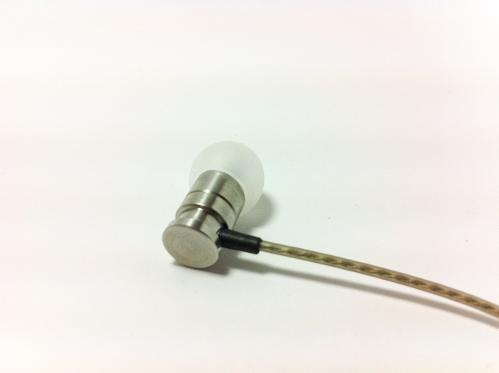I was bought in 10 monthes ago from AliExpress, and written a review in my blog ( refer to : http://rageworx.ddns.net/index.php/a-simple-review-of-earmax-e610/ )
Actually it was my curiosity for new dual BA unit - KNOWLES DTEC-30265, and soon I could know audio quality is not depends on name of Knowles.
Here my old review:
It is arrived in waited for long days. They simply described headphone specification in upper side of paper box (I can’t read chinese, so I paraphrased) :
Model name: ER610
Supported Frequency: 20 ~ 18000 Hz
Impedance: 20 ohm.
Sensitivity : 125 dB
Cable length: 1.2 meters
Ok. I have continue to open a box.
There’s anti-static protection, it was sealed. Need to tear vinyl.
Retail box contains simply these:
A Mic-controller-LESS headphone. NO mic, NO Controller. (I’ve been ordered mic controller)
A plastic protective pouch.
Two pairs of spare different size of silicon tips ( small and large )
Impossible to readabled Chinese texted paper.
Shape of product
This headphone seems to made with aliminium alloy. Weight is really light, And contruction is not looks cheap, But some finishing is not clear like end point of metal cut of hole on each unit to cable protecting rubber.
Nozzle of each unit applied protective metal mash. Silicon tips may compatibles with Apple IEM. Softness is not like Apple’s, more harder. It may problem for some people has weak ear skin tissue. (but I guess they don’t like IEMs, before worry about them)
Cable quality is not same with KZ series even it looks like similar. Much better quality in fitting and strength.
Hearing
First impact of hearing is just simple. It’s not like TWFK series of Knowles. Similar to UE Super.Fi 4. Feels like heavy and darker because of less high frequency as like below table.
(you could see graph in my blog)
Definitely this is not for Hi-Fi reference audio as they written on the cover of box. Sound is too coarse, not optimized. Rather than better KZ-ED9 or KZ-ATE series to buy this in only tuned sound quality. Much far from HiFi reference.
Conclusion
This headphone contruction quality is good. But If you like to listen musics, don’t like to recommend this. I don’t believe it used dual BA of Knowles. Sound is too coarse like sands in wind. Middle range of frequency is inflated, but high is seems dead like zombie but it never be rised again.
Additional valuation
It’s not enough to believe used dual BA even try to listen in days. Expected crispy high frequency like others, but this has nothing like that. No advantage if you are finding featured in most of dual BA IEM.
Actually it was my curiosity for new dual BA unit - KNOWLES DTEC-30265, and soon I could know audio quality is not depends on name of Knowles.
Here my old review:
It is arrived in waited for long days. They simply described headphone specification in upper side of paper box (I can’t read chinese, so I paraphrased) :
Model name: ER610
Supported Frequency: 20 ~ 18000 Hz
Impedance: 20 ohm.
Sensitivity : 125 dB
Cable length: 1.2 meters
Ok. I have continue to open a box.
There’s anti-static protection, it was sealed. Need to tear vinyl.
Retail box contains simply these:
A Mic-controller-LESS headphone. NO mic, NO Controller. (I’ve been ordered mic controller)
A plastic protective pouch.
Two pairs of spare different size of silicon tips ( small and large )
Impossible to readabled Chinese texted paper.
Shape of product
This headphone seems to made with aliminium alloy. Weight is really light, And contruction is not looks cheap, But some finishing is not clear like end point of metal cut of hole on each unit to cable protecting rubber.
Nozzle of each unit applied protective metal mash. Silicon tips may compatibles with Apple IEM. Softness is not like Apple’s, more harder. It may problem for some people has weak ear skin tissue. (but I guess they don’t like IEMs, before worry about them)
Cable quality is not same with KZ series even it looks like similar. Much better quality in fitting and strength.
Hearing
First impact of hearing is just simple. It’s not like TWFK series of Knowles. Similar to UE Super.Fi 4. Feels like heavy and darker because of less high frequency as like below table.
(you could see graph in my blog)
Definitely this is not for Hi-Fi reference audio as they written on the cover of box. Sound is too coarse, not optimized. Rather than better KZ-ED9 or KZ-ATE series to buy this in only tuned sound quality. Much far from HiFi reference.
Conclusion
This headphone contruction quality is good. But If you like to listen musics, don’t like to recommend this. I don’t believe it used dual BA of Knowles. Sound is too coarse like sands in wind. Middle range of frequency is inflated, but high is seems dead like zombie but it never be rised again.
Additional valuation
It’s not enough to believe used dual BA even try to listen in days. Expected crispy high frequency like others, but this has nothing like that. No advantage if you are finding featured in most of dual BA IEM.









